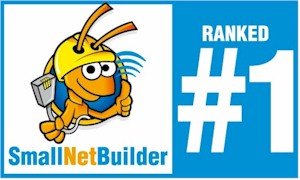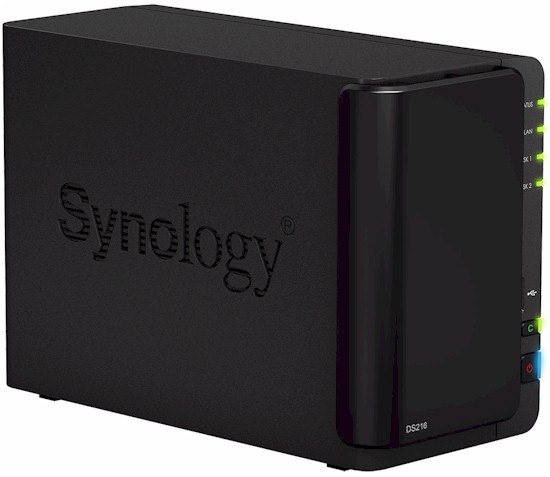
| At a glance | |
|---|---|
| Product | Synology Disk Station (DS216) [Website] |
| Summary | Two-bay dual-core Marvell-based NAS with large feature set |
| Pros | • Good performance • Broad feature set with lots of installable apps • Quiet |
| Cons | • Relatively expensive |
Typical Price: $0 Buy From Amazon
Introduction
Update 4/12/17 – Ranked #1 in RAID1 NAS Performance
Recently we’ve reviewed several 2-bay NASes targeted at the entry level market including the Western Digital My Cloud Mirror Gen 2 and, as part of a family review, the ASUSTOR AS1002T. But it’s been quite awhile since we’ve reviewed a 2-bay Synology. In fact, if you filter the NAS charts for the current testing method (black bars) and for 2 drives, the only Synology product that appears is Synology’s new DS216 – the subject of this review.
Throughout this review, I will be comparing the DS216 with WD My Cloud Mirror Gen 2 and the ASUSTOR AS1002T. All three NASes are targeted to the same entry level market, are based on the Marvell ARMADA 385 dual-core processor and have 512 MB of RAM.
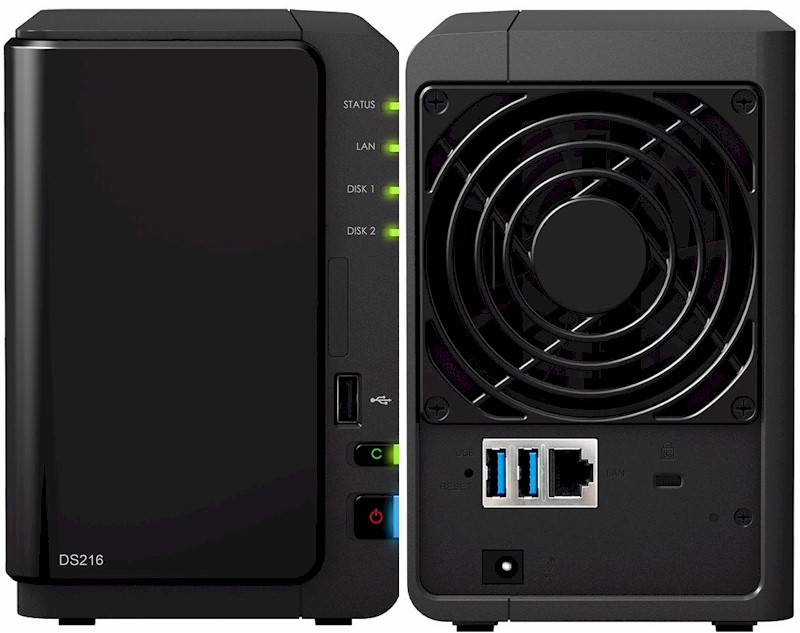
Synology DS216
From time to time, I find that it’s worth a reminder that the NAS Charts are a powerful product comparison tool. From the NAS Chart landing page, just select up to four NASes and click on “Features”. The chart below shows a portion of the complete feature table if you select the DS216 and the other two NASes being used for comparison in this review. It shows that the three products are really more alike than different.
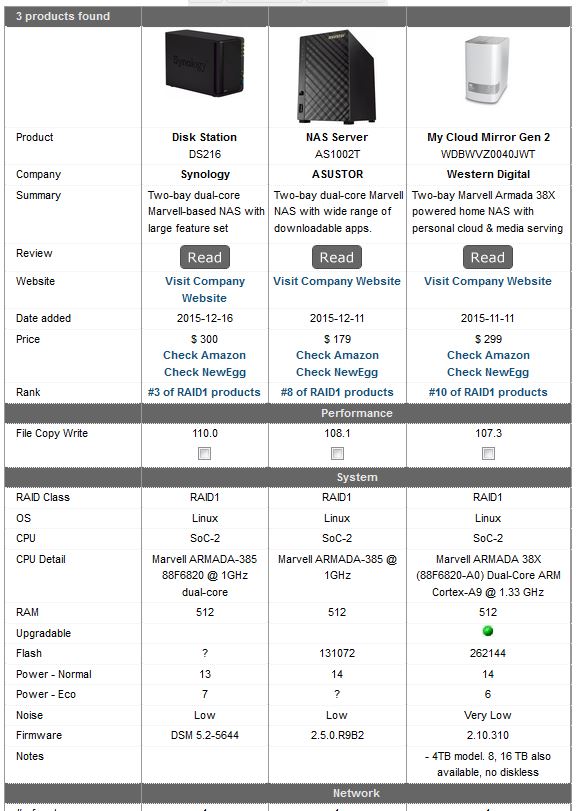
NAS Finder product comparison
The DS216 has its own Quick Installation Guide that includes step-by-step instructions for mounting disks into the disk trays, connecting the DS216 to power and LAN and configuring the NAS. After connecting to your DS216, a “first run” wizard walks you through the entire setup process. The Quick Installation Guide also provides rear and front panel callouts, shown below, as well as an LED Indicator Table found in Appendix B.
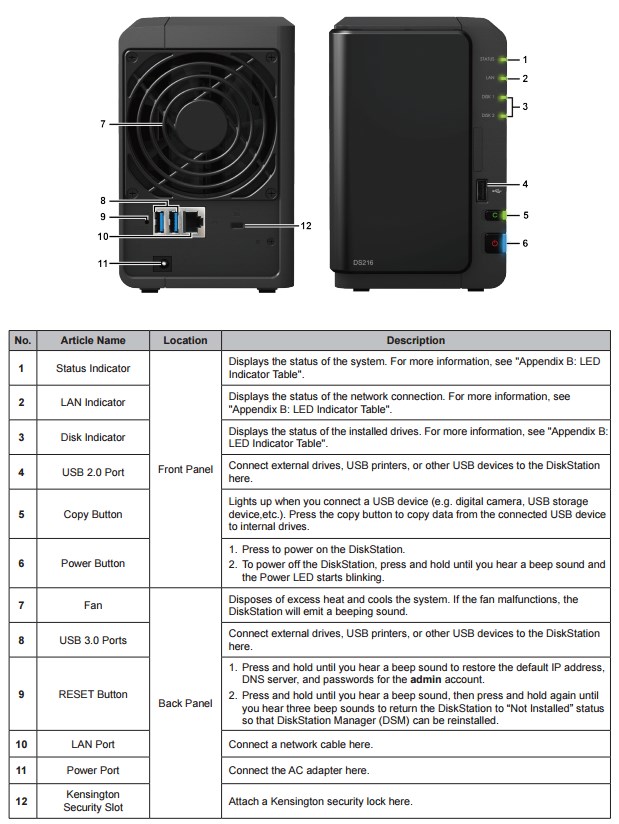
Synology DS216 rear and front panel callouts
Inside
We were unable to find an easy way to disassemble the DS216 without damaging it, so the components for the DS216 in the key component summary table below that are marked with a “(?)” are our best guess based on components used in similar Synology products.
| Synology DS216 | ASUSTOR AS1002T | WD My Cloud Mirror Gen 2 | |
|---|---|---|---|
| CPU | Marvell ARMADA-385 @ 1GHz dual-core | Marvell ARMADA-385 @ 1GHz dual-core | Marvell ARMADA 38X (88F6820-A0) Dual-Core ARM Cortex-A9 @ 1.33 GHz |
| RAM | 512 MB Samsung K4B4G1646D (?) | 512 MB Samsung K4B4G1646D | 512 MB Nanya NT5CC128M16FP-DI (x2) |
| Flash | 16 MB Macronix MX25L12835 (?) | 16 MB Macronix MX25L12835 | 256 MB Hynix H27U2G8F2CTR (x1) |
| Etherent | Marvell 88E1512 (?) | Realtek RTL8211E | Marvell 88E1512-NNP2 Gigabit Ethernet Transceiver |
| USB 3.0 | In CPU | In CPU | In CPU |
| SATA | Marvell 88SE9170 2 port SATA controller (on drive backplane for AS1004T) | Marvell 88SE9170 2 port SATA controller (on drive backplane for AS1004T) | In Marvell ARMADA 38X processor |
Table 1: Key component summary
Features
The DS216 uses the same operating system and has most of the same features found on other Synology two-bay NASes. The current operating system is DSM 5.2.5644, the version used to test our review unit. When DSM 5.0 was released last year, I wrote a full review of its features.
A list of DSM 5.2’s updated features can be found here and you can download the DSM 5.2 User’s Guide. Unfortunately, the link that used to take you to a live demo of DSM now takes you to a page full of tutorials. While there are lots of tutorials that contain good information, there’s nothing like a live demo that lets you play with some of the features and explore the UI.
The image below is the landing page of a Synology NAS running in my office. For illustration purposes, I’ve also enabled the on-screen widget that shows CPU and LAN utilization.
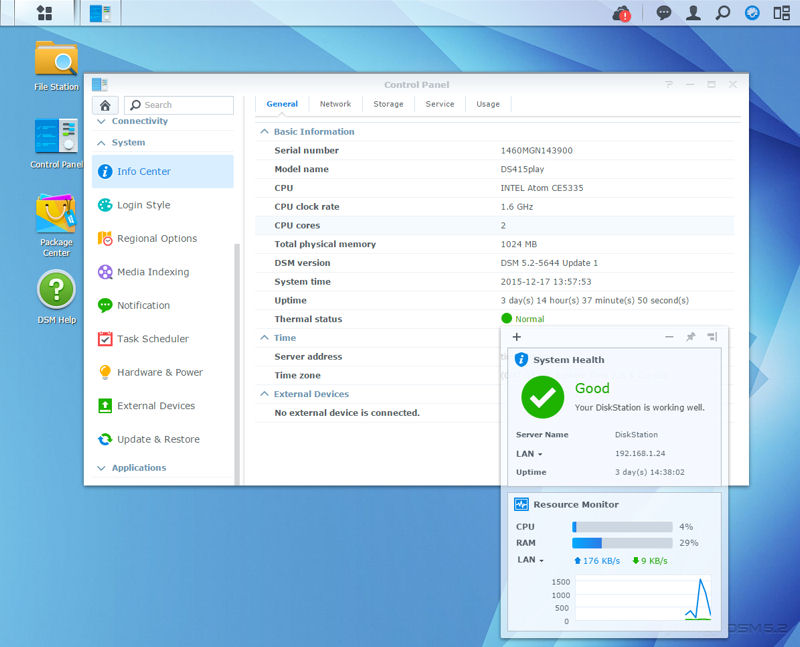
Synology DS216 landing page
One of the new features touted for the DS216 is a four-level brightness control for the front LEDs. You can adjust the brightness and then schedule whether you want to use the default brightness or the adjusted brightness. This would come in handy where the DS216 is installed in light sensitive areas such as a living room or in a sleeping area. The screenshot below shows the control found in the Hardware and Power control panel. Note: This feature is not available on all Synology models, such as my DS415Play.
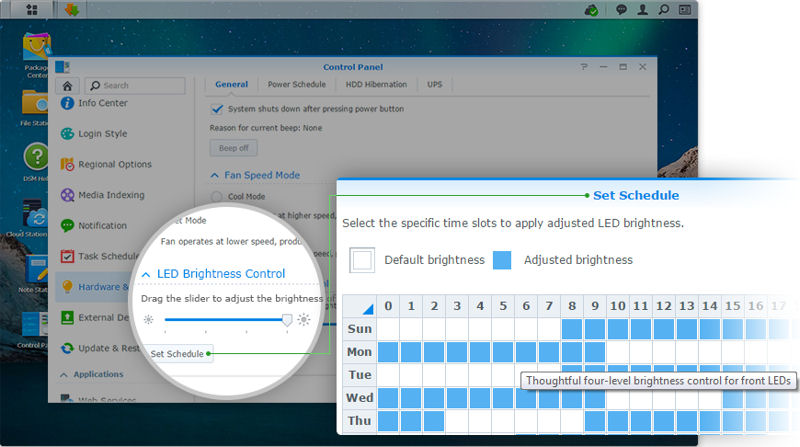
Synology DS216 LED Brightness Control
Performance
DSM 5.2-5644 firmware was loaded onto the DS216 and performance tests were run using the Revision 5 NAS test process. All tests were run using Western Digital Red 1 TB (WD10EFRX) drives (x2 SNB supplied).
The composite image below shows File Copy Write and File Copy Read performance for two drive NASes tested with the Revision 5 test process. The DS216 turned in 110.0 MB/s which virtually tied the other top-of-the chart scores on the File Copy Write test, but had a slightly slower 104.8 MB/s for File Copy Read Performance.
Note that quite a few NASes in both charts cluster between 109 and 110 MB/s. That’s about the maximum throughput that you can achieve with single client Gigabit Ethernet testing. What’s important here is the DS216 is in the top tier and within the 5% ranking tolerance for the File Copy Read benchmark.
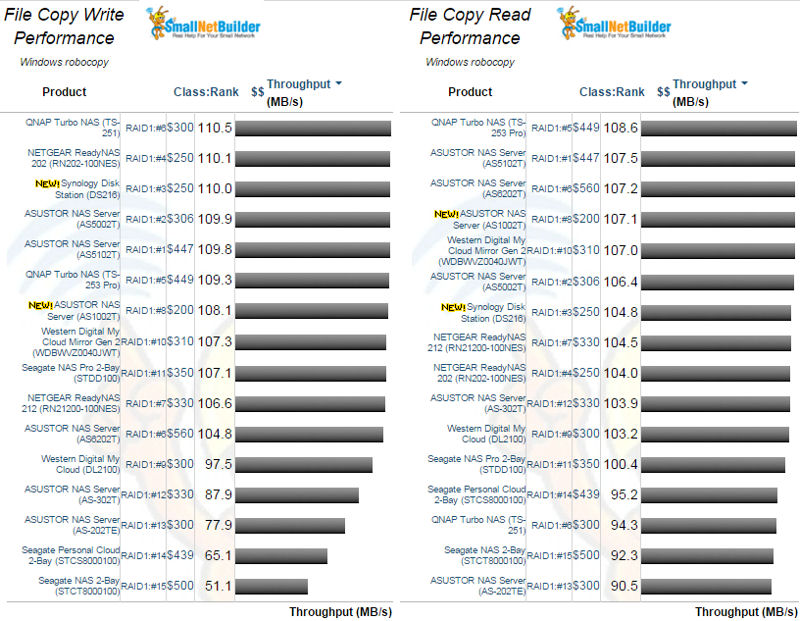
File Copy Write and File Copy Read performance for two drive NASes
The benchmark summaries below show the individual test results for the Synology DS216, Western Digital My Cloud Mirror Gen 2 and ASUSTOR AS1002T. You might expect that with the same processor and the same amount of memory that all three NASes would turn in very similar results. For the most part, they did.
For File Copy Write and Read performance as well as NASPT File Copy From and To NAS performance, the Synology DS216 and consistent performance for both RAID levels for both types of tests. There were a couple of anomalies, however. For RAID 1 File Copy Read, the AS 1002T’s performance was about 11% lower than the corresponding File Copy Write. The RAID 1 File Copy tests for the WE My Cloud Gen 2 were exactly opposite. The Gen 2 turned in a slower 88.3 MB/s on the File Copy Write test as compared to 100.9 Mb/s on the File Copy Read test.
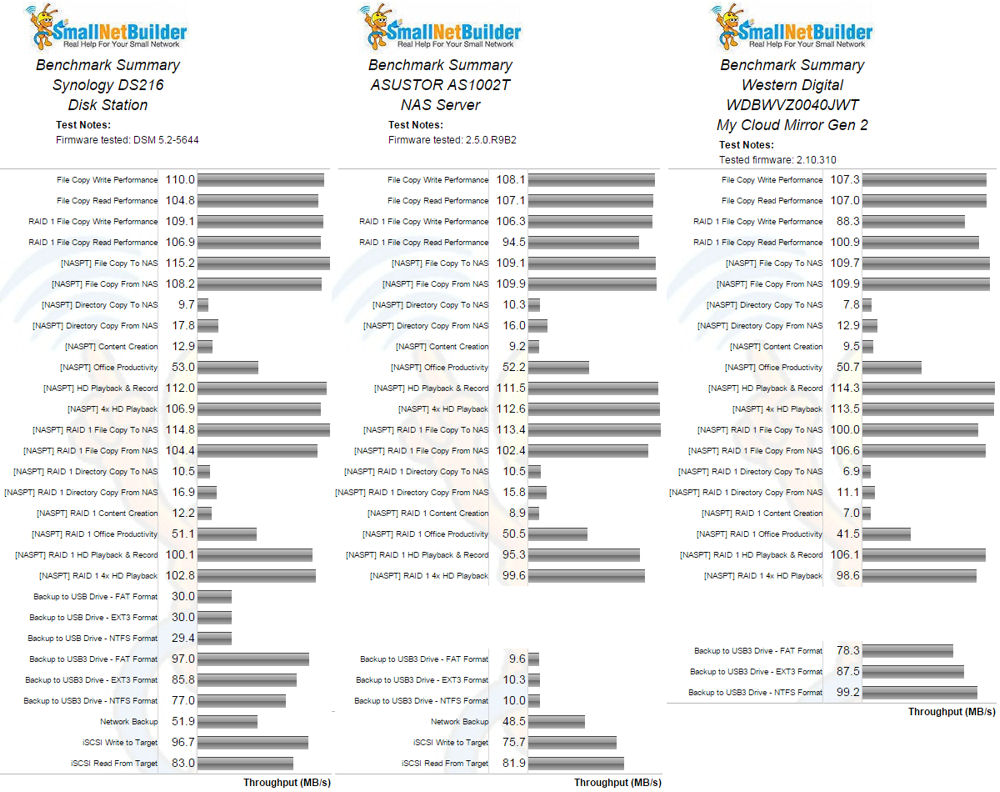
Benchmark summary comparison
The DS216 is the only NAS in this comparison with both USB 2.0 and USB 3.0 ports, so USB Backup results were reported for both interfaces for all three supported file types. For USB 3.0 Backup, the DS216 had the fastest throughput (97.0 MB/s) for the FAT format. The WD My Cloud Mirror Gen 2 outperformed both of the other NASes for EXT3 (87.5 MB/s) and for NTFS (99.2 MB/s) formats. The ASUSTOR AS1002T trailed the other two with backup speeds hovering around a poor 10 MB/s. For Network backup and iSCSI Read to Target and iSCSI Read from Target, the DS216 outperformed the AS1002T. The WD Gen2 doesn’t support iSCSI or network backups.
The NAS Ranker set for RAID1 assigns the DS216 a #3 rank The ASUSTOR AS1002T came in at #8, trailed by the Western Digital My Cloud Mirror Gen 2 at #10. If you’re looking for a bargain, sorting the ranker by ascending price comes up with NETGEAR’s diskless RN202 ReadyNAS for $200 ranked at #4.
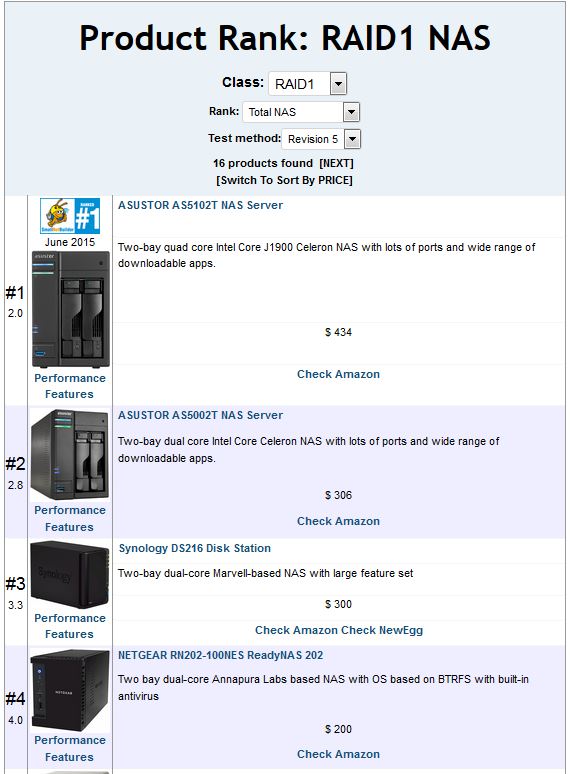
RAID1 NAS Ranking
The chart below shows individual and category scores for the three NASes I’ve been comparing. For the total NAS score, the Synology DS216 was a clear winner with a Total NAS rank of #3. However, in some individual categories, rankings were closer than the Total NAS Rank might otherwise indicate. For Write Benchmarks, the DS216 tied with the AS1002T with a #3 ranking trailed by the WD Gen 2 which ranked #10.
The DS216 was the clear winner for both the Read and Mixed Read/Write categories. For the Video category the DS216 ranked behind the WD Gen2 and the AS1002T. The backup category score for the AS1002T would have been much worse if it hadn’t been pulled up by relatively decent Rsync Backup.
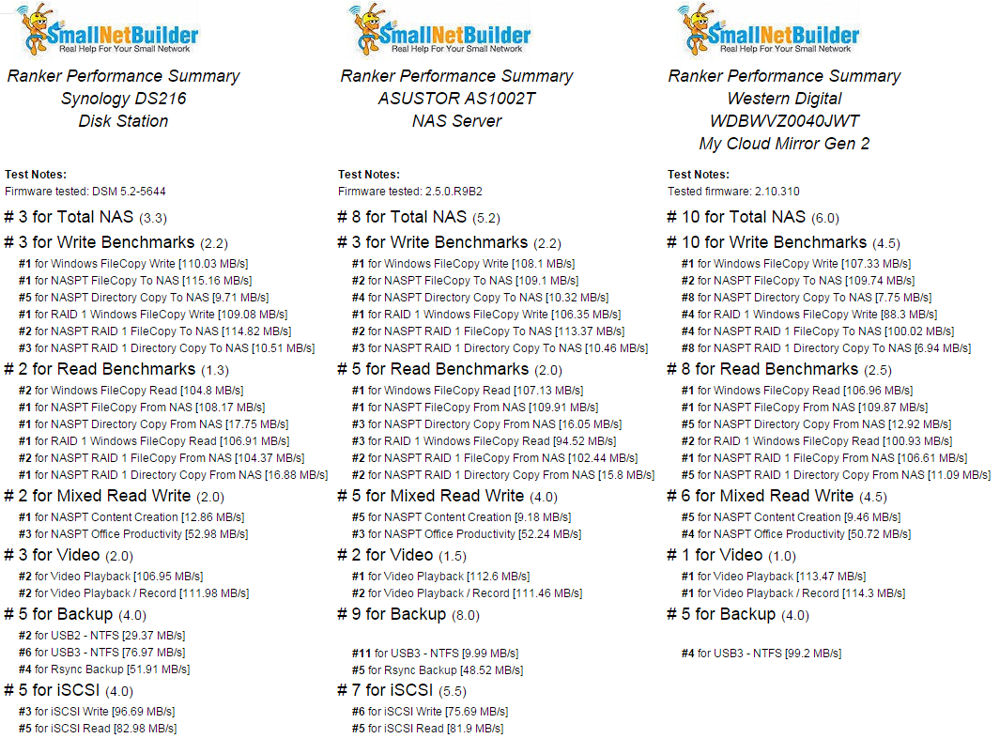
Ranker Performance Summary comparison
Closing Thoughts
As I concluded in my review of the Western Digital My Cloud Gen 2, it’s difficult for a NAS manufacturer to compete with a disk manufacturer who also markets NASes. Amazon currently shows the WD My Cloud Gen 2 at $299, but that’s with two 2 TB hard drives included. To get an equivalent amount of storage on either the $300 DS216 or $179 AS1002T, you’d have to spend another $168 for two 2 TB WD Reds, taking the total cost up to $468 or $347 respectively.
I should note the DS216 is not the least expensive two-bay NAS Synology currently makes. That would be the DS216se, that Amazon currently sells for $170; $130 cheaper than the DS216. There is also the DS215j that we’ve been asking Synology to review for over a year; it sells for just shy of $200. But the least expensive two-bay NAS Synology would send was the $300 DS216, saying they preferred we review their latest models.
Either the DS216 or ASUSTOR AS1002T will provide better performance than the WD Gen 2. But looking at the individual benchmark tests as well as the category scores shows that in many cases, depending on how you will use your NAS, the performance differences aren’t great enough to justify such a large premium.
While both Synology and ASUSTOR offer a larger library of applications that can run on the server, those might be features that are of little value to you. For now, the WD My Cloud Mirror Gen 2 still offers the best overall storage value for a two-bay NAS.
Update 4/12/2017 – With the discontinuance of two highly-ranked ASUSTOR products, the DS216 is now ranked #1 for RAID 1 NAS Performance. Synology’s DS216j and QNAP’s TS-231P now also tie for best combination of price and performance in two-bay NASes.
